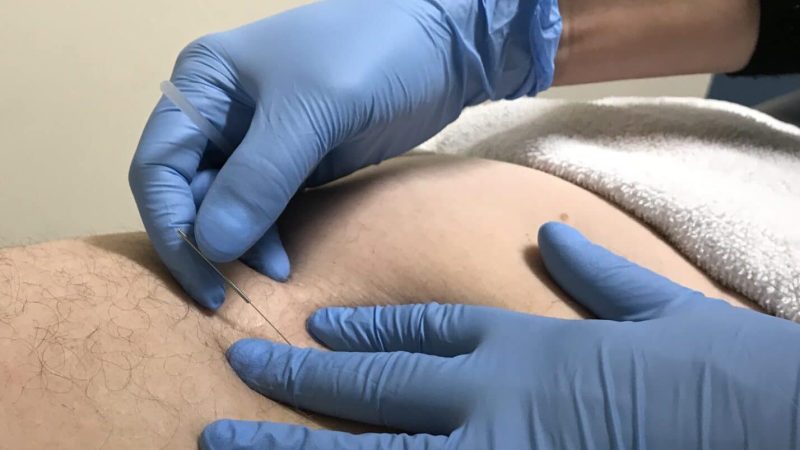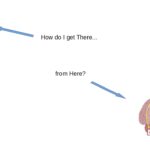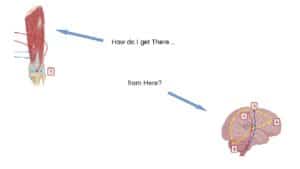
- Are you stretching everyday, but still have muscle tension that won’t relax?
- Do you have a muscle that feels like it always needs to be massaged out?
- Does your active lifestyle leave your body feeling sore and tight on most days?
Stubborn Muscle Pain Needs Specific Help
If you answered “yes” to one or more of the above questions, you may be a candidate for dry needling!
Dry needling is a skilled technique that uses a non-medicated, solid filiform needle to target and release underlying myofascial trigger points. A myofascial trigger point is a taut band of muscle fibers that cause spontaneous pain, loss of range of motion, and restricted movement.
Oftentimes, trigger points develop when a muscle is overused or suffers a direct trauma. Additionally, an increased time of psychological stress can also cause trigger points. Trigger points can cause referred pain patterns to other parts of the body. Dry needling accesses trigger points that are deep in the muscular system. It can help you break through a plateau in healing!
Dry needling is an effective and safe treatment to compliment your physical therapy visits. It can help you break through a plateau in healing!
Conditions Dry-Needling Helps
Dry needling is an effective and safe treatment to compliment your physical therapy visits. For instance, it can be used to improve conditions such as:
- Acute muscle pain after a fall or accident
- Low back pain
- Neck pain
- Fibromyalgia
- TMJ disorder
- Muscle spasticity after a stroke
- Poor muscle recovery
- Plantar fasciitis
- Arthritis related pain of the hips and knees
- Rotator cuff problems
How Dry-Needling Works
Simply put, “It works great!”
However, if you like the technical side of things, here you go.
When the dry needle reaches a trigger point, a twitch-response happens, like a small spasm in the muscle. This reflex reduces pain-producing chemicals in the cells and improves blood flow, bringing more oxygen to the trigger point. Dry needling is often a compliment to your treatment. It can be used before or after other manual treatment and/or strengthening exercises.
Dry needling treatment is tailored to your unique problem. The time it takes to “work” can vary. We recommend dry needling on three occasions (3x) in the painful muscles to determine effectiveness. After the initial treatment, many people say that soreness lasts 1-2 days. After that, they have a day or two of relief. But then symptoms can creep back in. The second needling session provides a longer window of relief and quicker recovery time. This treatment has a cumulative effect. Consequently, as you heal, dry needling treatment frequency is reduced, until you have regained full function.
Alex Ewart, DPT, OCS, CSCS, provides this service. If you have any questions about this treatment method please contact him here: aewart@lifestrengthpt.com.
Want more information?
You can find additional information in the following articles:
American Physical Therapy Association: Clinical Practice Resource Paper
http://www.apta.org/StateIssues/DryNeedling/ClinicalPracticeResourcePaper/
American Physical Therapy Association: Dry Needling by a Physical Therapist, What You Should Know
https://www.choosept.com/resources/detail/dry-needling-by-physical-therapist-what-you-should
Dry Needling: Peripheral and Central Considerations
https://www.ncbi.nlm.nih.gov/pmc/articles/PMC3201653/pdf/jmt-19-04-223.pdf
QUICKNAV
FREE Running Injury Report
Latest Posts

Are You Swimming Upstream or Going with the Flow?
“My doctor said I’m “swimming upstream.” He based his statement on the fact that I have a long-standing problem.”
What a troubling statement.
This led my patient to believe that his symptoms would be tough to get rid of, and might not be able to be changed.

The Power of Small Changes to Introduce Big Effects!
Let’s face the facts…most people do not like change of any kind. Change can be daunting, especially when making drastic changes for our health.
Have you been told by your doctor that you have to exercise more, lose weight, and cut out sugar? What about getting more sleep? Reading more books, reducing your screen time? These are great advice for almost all of us…

How to Lose Your Inhibitions
What if your inhibitions hold you back from making continual improvements?
You might be surprised to find out that your movements and abilities are not always what you think they are…especially if you have ever experienced an injury.

Are You Swimming Upstream or Going with the Flow?
“My doctor said I’m “swimming upstream.” He based his statement on the fact that I have a long-standing problem.”
What a troubling statement.
This led my patient to believe that his symptoms would be tough to get rid of, and might not be able to be changed.

The Power of Small Changes to Introduce Big Effects!
Let’s face the facts…most people do not like change of any kind. Change can be daunting, especially when making drastic changes for our health.
Have you been told by your doctor that you have to exercise more, lose weight, and cut out sugar? What about getting more sleep? Reading more books, reducing your screen time? These are great advice for almost all of us…

How to Lose Your Inhibitions
What if your inhibitions hold you back from making continual improvements?
You might be surprised to find out that your movements and abilities are not always what you think they are…especially if you have ever experienced an injury.
